Process of establishing design requirements and selecting alternative configurations for conceptual design of a VLA
Bo-Young Be,Sngho Kim,*,Je-Woo Lee,Nhu Vn Nguyen,Bong-Cheul Chung
aDepartment of Aerospace Information Engineering,Konkuk University,Seoul 143-701,Republic of Korea
bKonkuk Aerospace Design,Airworthiness Research Institute,Konkuk University,Seoul 143-701,Republic of Korea
Process of establishing design requirements and selecting alternative configurations for conceptual design of a VLA
Bo-Young Baea,Sangho Kima,*,Jae-Woo Leea,Nhu Van Nguyenb,Bong-Cheul Chungb
aDepartment of Aerospace Information Engineering,Konkuk University,Seoul 143-701,Republic of Korea
bKonkuk Aerospace Design,Airworthiness Research Institute,Konkuk University,Seoul 143-701,Republic of Korea
Aircraft configuration;Conceptional design;Design requirements;Requirement analysis;Very light aircraft(VLA)
In this study,a process for establishing design requirements and selecting alternative configurations for the conceptual phase of aircraft design has been proposed.The proposed process uses system-engineering-based requirement-analysis techniques such as objective tree,analytic hierarchy process,and quality function deployment to establish logical and quantitative standards.Moreover,in order to perform a logical selection of alternative aircraft con figurations,it uses advanced decision-making methods such as morphological matrix and technique for order preference by similarity to the ideal solution.In addition,a preliminary sizing tool has been developed to check the feasibility of the established performance requirements and to evaluate the flight performance of the selected configurations.The present process has been applied for a two-seater very light aircraft(VLA),resulting in a set of tentative design requirements and two families of VLA configurations:a high-wing configuration and a low-wing configuration.The resulting set of design requirements consists of three categories:customer requirements,certification requirements,and performance requirements.The performance requirements include two mission requirements for the flight range and the endurance by reflecting the customer requirements.The flight performances of the two configuration families were evaluated using the sizing tool developed and the low-wing configuration with conventional tails was selected as the best baseline configuration for the VLA.
1.Introduction
The life-cycle of an aircraft is divided into the following phases:concept studies on customer requirements,conceptual design,preliminary design,detailed design and development,production,operation and maintenance,decommissioning,and recycling.The conceptual design phase includes several important tasks such as the design requirement analysis,the feasibility study of development,the demand forecasting and market analysis,the conceptual aircraft configuration design and subsystem definition,and the establishment of initial planning for aircraft development.Accordingly the conceptual design phase is most influential in the aircraft life-cycle.Although relatively small investments are necessary during the conceptual design phase,large efforts should be made since 70%–90%of a design is defined in this phase.Therefore,development of a logical and efficient conceptual design method will be of great importance.In the conventional conceptual design approaches,the process of selecting the best configuration typically employs a trial and error method based on the experience of a designer.This increases the development time and cost due to the large number of design iterations.
Efficient conceptual design requires a series of wellorganized processes that enable designers to make logical and objective decisions on an aircraft design.Many methodologies that can be applied to such processes have been presented in the field of industrial engineering,but there have been very few developments and applications of the methodologies in the conceptual design phase of aerospace engineering.Mavris et al.1,2successfully established an objective and efficient design process.They excluded a designer’s subjective judgment from their proposed aircraft conceptual design process,which includes concept establishment,selection of alternative configurations,and an assessment process.Park3improved Mavris’design process for optimum alternative configurations that re flect user requirements.Yoon et al.4presented an optimum baseline aircraft con figuration selection process using a decision-making model that considers both airworthiness certification regulations and user requirements during the concept design phase.
In this study,a systematic design requirement analysis,which is an early stage of the aircraft conceptual design phase,is conducted to produce the design requirements considering user requirements,marketability,and certification regulations.Moreover,a baseline configuration design process is established to suggest objective and reasonable baseline configurations that satisfy the resulting design requirements.
For aircraft design purposes,we have strived to make a logical flow in order to select the design requirements and baseline configurations.In addition,the internal data of the process were consistently managed to reflect the design requirements properly.A two-seater very light aircraft(VLA)was selected for the present study because it is anticipated that two-seater VLAs will be in demand as aero leisure sports are becoming popular domestically and globally.
For the requirement analysis,the voices of users,designers,and clients were collected through a survey of various groups of people including VLA pilots,students and faculty in aerospace engineering,and aviation company engineers.The proposed process of selecting baseline configurations used the quantitative requirements analysis methods(see Fig.1).It also used initial sizing and a performance analysis respectively to generate the baseline aircraft configurations and to evaluate whether they satisfy the mission and performance requirements.
2.Building model
2.1.Brainstorming
The systematic method proposed in this paper uses a series of decision-making models to address the design requirements and the design alternatives in a more logical,objective,and quantitative manner.5In this section,the decision-making models used in the present method are briefly described.
2.2.Affinity diagram
This method is a long-term human intellectual activity to organize data by grouping the data into groups based on natural relationships.The term ‘a(chǎn)ffinity diagram” was devised by Jiro Kawakita in the 1960s and has been used as a business tool to organize ideas and data.6,7The method allows a large number of ideas stemming from brainstorming to be sorted into groups for review and analysis.
2.3.Tree diagram
The tree diagram8is a graphical method that lays out a hierarchical structure of objectives and measures systematically to find the most appropriate measures in order to achieve the goals.In general,this method is used for spreading out the subordinate goals of the primary goal or for breaking down a large-scale project into progressively smaller feasible tasks.
2.4.Analytic hierarchy process
A psychology and mathematics based method,the analytic hierarchy process(AHP),is a multi-criteria decision-making(MCDM)method for making decisions about complicated problems rationally and efficiently.The AHP was developed by Satty in the 1970s based on the fact that the brain uses a phased or hierarchical analytic process when a human makes a decision.9

Fig.1 Quantitative requirements analysis methods.
During the AHP,the entire decision-making process is divided into several phases and each phase is analyzed to make a final decision.Users firstly decompose their decision problem into a hierarchy of more easily comprehended sub-problems.Once the hierarchy is built,the decision makers systematically rank the order of importance of the elements in the same hierarchical level by performing pairwise comparisons with respect to their impacts on an element above them in the hierarchy.Since the AHP converts these evaluations into numerical values that can be processed until numerical priorities are calculated for each of the decision alternatives,it has been widely used for MCDM problems.
2.5.Quality function deployment
Quality function deployment(QFD)10was originally developed as a quality assurance method by Mizuno and Akao in 199411and has been used in a wide variety of services and consumer products.QFD is described as a method to transform user demands into design quality,to deploy the functions forming quality,to deploy methods for achieving the design quality into subsystems and component parts,and ultimately to specific elements of the manufacturing process.Quality methods prior to QFD focused on reducing internal defects,but QFD focuses on transforming customer needs into engineering characteristics of a service or product.The house of quality(HOQ)tool is used to materialize QFD(see Fig.2).
2.6.Morphological matrix
Morphological analysis12is a structured or systematic method developed by Fritz Zwicky(1967,1969)for exploring all the possible solutions to a multi-dimensional,non-quantified complex problem.13The method uses a morphological matrix to analyze and list the major components of a system and to generate and identify alternative configurations of the system by exploring possible combinations of the components listed.A designer can determine some possible alternatives,eliminating the illogical solution combinations.
2.7.Technique for order preference by similarity to ideal solution
The technique for order preference by similarity to the ideal solution(TOPSIS)14was firstly developed and introduced by Hwang and Yoon in 1987.It is based upon the concept that the chosen alternative should have the shortest distance from the positive ideal solution(PIS)and the farthest from the negative ideal solution(NIS).Using this method,the alternatives presented as the solutions to a multi-criteria decision-making problem may be the closest to the PIS;that is,the most beneficial alternative solutions are to be selected.
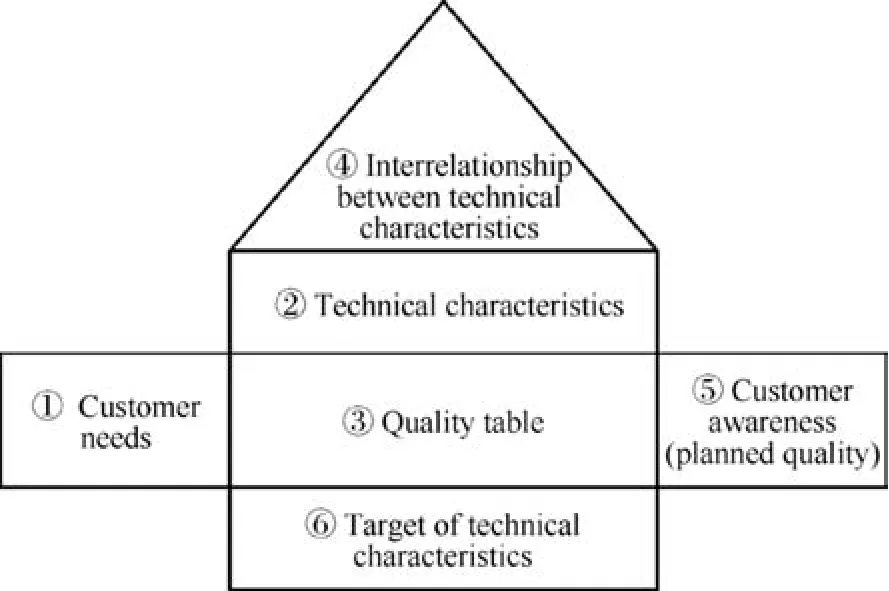
Fig.2 House of quality(HOQ).10
As the design requirements are determined in more detail,brainstorming,the af finity diagram,the tree diagram,the AHP,and QFD are used sequentially based on the characteristics of the decision-making models.Similarly,as the design alternative configurations are defined in more detail,QFD,the morphological matrix,and the TOPSIS are used systematically.A detailed description of how the decision-making models are used in the design requirement analysis and the design baseline configuration selection process can be found in Sections 3 and 4.
3.Systematic process
In this study,a systematic process of establishing a quantitative standard for the design requirement analysis and the baseline configuration selection in the conceptual aircraft design phase was developed by applying the quality design technique and the decision-making technique.The whole process can be divided into the design requirements analysis process in the initial conceptual design phase and the baseline configuration selection process.The two processes can be schematized into one process using the decision-making model as shown in Fig.3.For the design requirements analysis process,the requirement categories are divided into user requirements,competition-based requirements,and certification regulation requirements for analysis.The requirement analysis results of the three requirement categories are used to establish temporary design requirements and mission profile of the aircraft.Based on those temporary design requirements and mission profile,design alternatives are selected and then primary design requirements are suggested through the verification process composed of both initial sizing and performance analysis.
The process of selecting baseline configurations among the alternatives is also performed using the resulting primary design requirements as the decision standards.During this process,the selected alternative con figurations and baseline configurations are used as necessary input parameters for the sizing analysis tool.Finally,the best baseline con figuration is selected for the rest of the conceptual design.
The key concept of this study,the decision-making process,can be carried out by aggregating information on the alternatives and preferences of the decision makers.There is a need to quantify the standard elements to conduct a quantified evaluation of the design candidates since there is a risk of contradictions among the standard elements in simple comparison.The user requirements analysis process uses an affinity diagram and tree diagram in order to organize the user requirements collected through the survey and brainstorming as shown in Fig.4.
The MCDM methods,AHP and QFD,are used in grasping and laying down the priorities of the organized design elements.The results of the AHP and QFD are then used for setting the range of the design requirements and evaluating the baseline configuration.
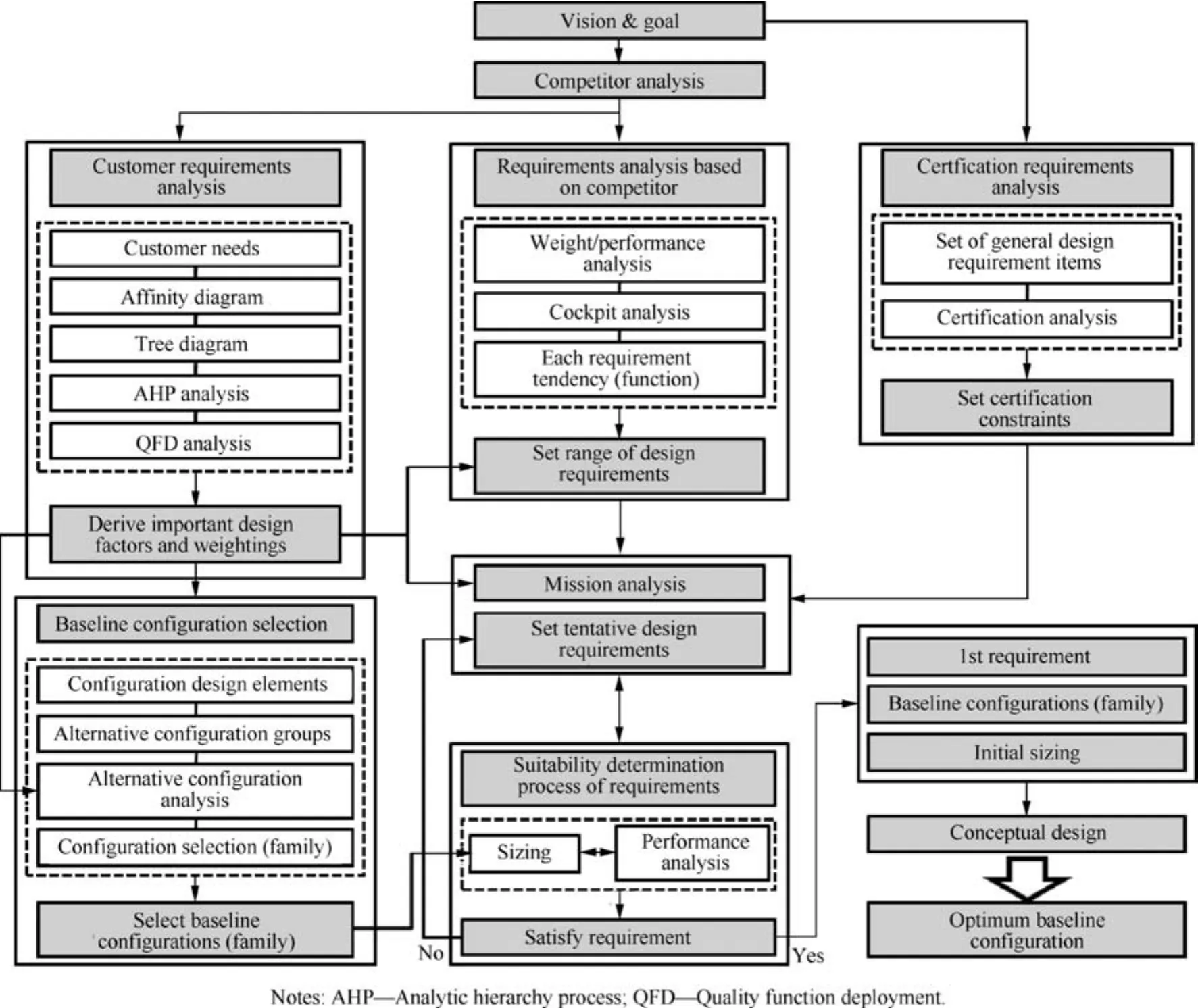
Fig.3 Quantitative requirement analysis process for baseline configuration selection.

Fig.4 User requirements analysis process.
The function that determines the scope of design requirements is built through survey and analysis of the competing models.In addition,the certification regulations,which are a social restriction,are investigated and applied to the requirements setting.Through this process,temporary design requirements and mission profiles can be developed and verified using a simple sizing analysis tool.Finally,the primary design requirements are generated as a result of the initial conceptual design and may be revised and supplemented during the rest of the conceptual design phase.15
As shown in Fig.4,the baseline configuration decision process uses the morphological matrix to generate alternative configurations.Themulti-attributedecision-making method,TOPSIS,is used to obtain an optimal alternative.The AHP and QFD results presented above are used as weighting factors for the evaluation of alternatives.Two or more families of baseline con figurations can be selected for design.
The enhanced in-house sizing methodology and tool were developed and validated for various type of aircraft such as unmanned aerial vehicles(UAVs),unmanned combat aerial vehicles(UCAVs),regional jet aircraft,and electric powered light aircraft from the given set of requirements including users and airworthiness regulations.16The sizing tool is composed of the integration of a simplified aerodynamics,corrective weight fraction from recent aircraft database and a simplified mission and performance analysis module to perform the inverse performance design by the support of an optimization loop to ensure the satisfaction of users and airworthiness regulation requirements.In addition,the proposed sizing tool reduces the assumptions at the preliminary sizing stage by introducing a rough estimation from a similar aircraft database collection.The in-house sizing tool yields relatively good and quick results at the maximum error of 15.23%compared to the existing MQ-1 Predator wing area data in the sizing stage,while the existing sizing tool provides many assumptions for aerodynamics analysis and an over-predicted empty to gross weight ratio based on meta aircraft regression data.Therefore,the in-house sizing tool is developed and used for selecting the alternative configuration for the conceptual design of VLAs.
This sizing tool with the AHP,QFD,and mission analysis results will be used to constitute the optimization problem.The sizing analysis is carried out for each family of baseline configurations.
Then a final baseline configuration can be selected through the TOPSIS analysis using the sizing and the user requirements analysis results.This process can be applied to two-seater VLAs as well as to diverse aerospace systems including other fixed-wing aircraft and rotary-wing aircraft.
4.Implementation and results for a two-seater VLA
4.1.Introduction to two-seater VLA and purpose of development
A two-seater VLA is an aircraft classified under the Certification Specifications for Very Light Aircraft(CS-VLA)by the European Aviation Safety Agency(EASA).It has two or fewer seats.Its maximum take-off weight is 750 kg or less and its stall speed is 83 km/h(45 kn)or less.It is a single-engine plane that is only allowed to fly during the day,and the engine must have an ignition plug or be a compressed ignition type engine.6
It is predicted that two-seater VLAs will account for over 50%of global sales in the next ten years,and the demand for VLAs is on the rise.The US government has supported the aviation industry with the law of the American Society for Testing and Materials(ASTM)for light sports aircraft(LSA),newly enacted in 2004,to fulfill the desires of the American people for flying.Currently,more than 230,000 light aircraft are in operation,and light aircraft for leisure will be in great demand globally in the near future.
The advantages of the competing aircraft models presented as part of a sales strategy by other companies were examined to establish a development goal of the two-seater VLA in this study.The resulting advantages were flight attributes(speed,flight range,fuel consumption rate,stability,etc.),comfort on long flights(interior,pilot seat size,passenger seats,etc.),visibility(front,sides,openable windows during flight,etc.),aircraft with stylish exterior,safety(fuel tank location,material,safety devices,etc.),smooth landing(landing gear,seats,etc.),doors for comfortable entrance and easy loading,and electrical equipment for easy and stable piloting(Garmin products,various cockpit forms,electrical piloting,etc.).Based on this information,the development goal was established as shown in Fig.5.
4.2.Analysis of competing models
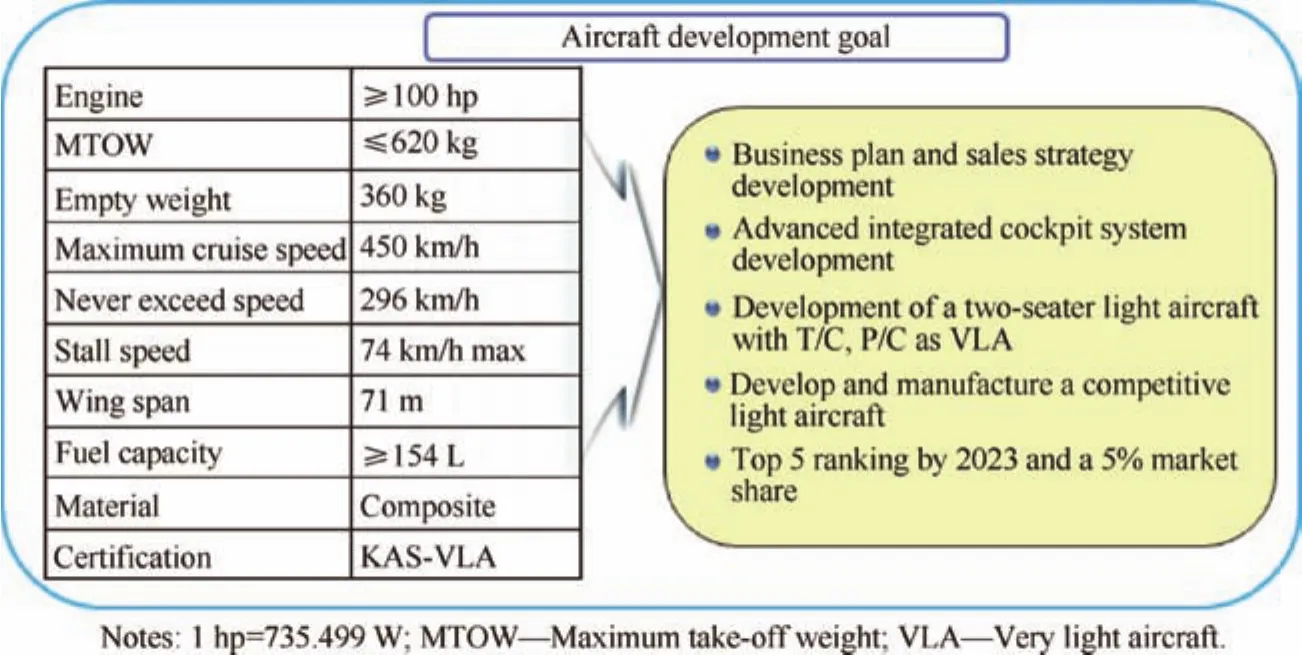
Fig.5 Development goal.
The CS-VLA is the certification regulation applied to the twoseater VLA.This class of aircraft has a maximum take-off weight(MTOW)of 750 kg but the target MTOW was set as a maximum of 650 kg in order for the VLA to have stronger competitiveness so that it can also enter the LSA market,with simple modification if necessary.An LSA is defined as an aircraft that is a heavier-than-aircraft or a lighter-than-aircraft,other than a helicopter,with a maximum gross take-off weight of no more than 560 kg for a lighter-than-aircraft,or 600 kg for a heavier-than-aircraft not intended for operation on water or 650 kg for an aircraft intended for operation on water.For these reasons,both VLA class and LSA class aircraft need to be considered as competitors.The authors have conducted research on the exterior features,performance,materials,and engines of the selected VLA models that were available for sale and the best-selling LSA models based on the market share dataprovided bytheFederalAviation Administration(FAA)as of December 2010(Fig.6).
4.3.Analysis of user requirements
In order to analyze the user requirements for the two-seater aircraft in a quantitative and systematic way,we have conducted an analysis of the user requirements by applying the decision-making model.17User requirements have been determined through a survey and brainstorming in which undergraduates,aircraft developers,and VLA pilots participated.Then,an affinity diagram and a tree diagram were completed based on the user requirements investigated.Using the affinity diagram(see Fig.7),the top-level user requirements were classified into marketability,environmental friendly,safety,and performance as shown in the figure.Fig.8 shows the results of the analysis using the tree diagram.
Here,the Level 1 user requirements are the voice of customer(VOC),namely,what customers need with regard to aircraft quality.The Level 3 user requirements are the voice of engineer(VOE),namely,what engineers consider in aircraft design to satisfy the customer needs with regard to aircraft quality.
The AHP18and QFD were conducted through a survey based on the resulting tree.A total of 31 personnel including VLA developers,VLA pilots,and foreign advisors participated in the survey.Every pair of the top-level user requirements,namely marketability,performance,environmental friendly and safety,were compared using the AHP technique in order to estimate the relative importance of the top-level user requirements.Only data with a consistency index of less than 20%were used to ensure a reliable estimation.The results are shown in Fig.9.
The AHP and the primary QFD are linked,and the primary QFD and the secondary QFD are linked.The primary and secondary QFD results for Levels 1,2,and 3 of the tree diagram are shown in Figs.10 and 11.The values of the weighting result are normalized so that the sum of the weighting result becomes 1.The Level 2 categories of the tree diagram and the results of the primary QFD are used as the evaluation categories and weights when the baseline configuration is selected.The categories from the results of the secondary QFD thataredirectly related to the design requirements affect the design requirement settings so they are used for the competing model-based requirement analysis and the mission analysis
4.4.Analysis of competing model based requirements
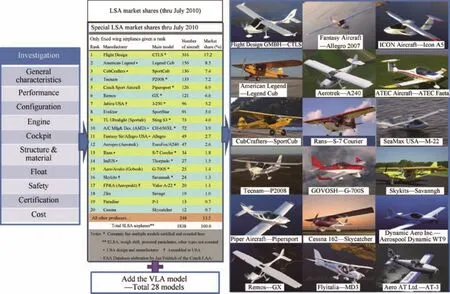
Fig.6 Analysis of competing models.
Data gained by examining the competing models were used to analyze the trends in weight and performance.The importance figures related to performance among the user requirement analysis results are presented in Table 1.Performance functions for the maximum take-off weight were extracted from the performance trends investigated.Trends of stall speed(for landing configuration),speed limit,service ceiling,maximum cruising speed,take-off distance(including ground roll),landing distance(including ground roll),flight range,and endurance were formulated as functions.As the development goals previously presented,a 10%improvement in the design requirement values for performance compared to those of the competing models was suggested using the performance functions.These suggested design requirements for performance were tentative and will be refined after a feasibility study using the initial sizing and the performance analysis.
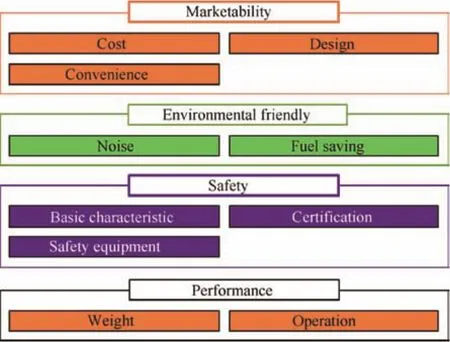
Fig.7 Affinity diagram.
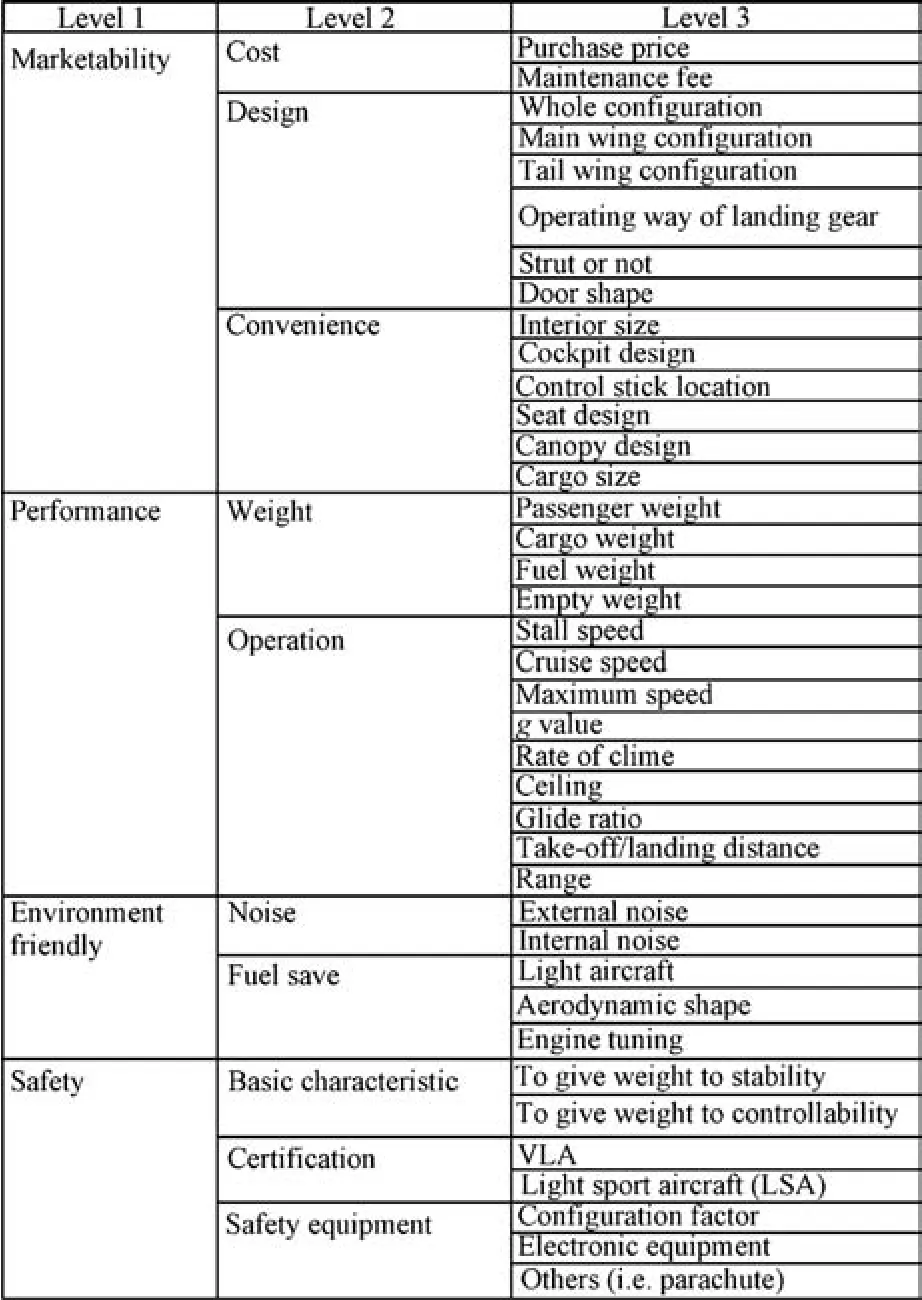
Fig.8 Tree diagram.
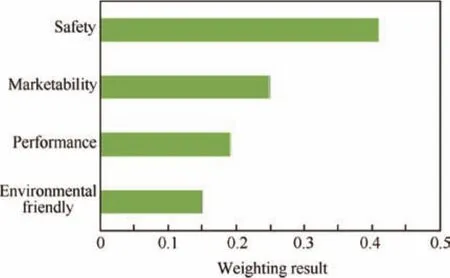
Fig.9 AHP results.

Fig.10 Primary QFD results.
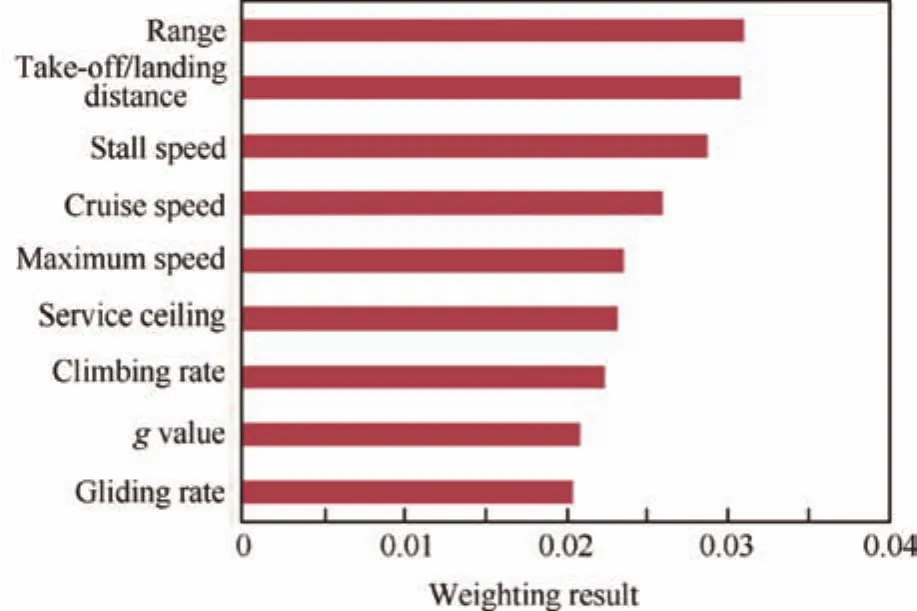
Fig.11 Secondary QFD results.
4.5.Analysis of certification regulation requirements
Two-seater light aircraft need to satisfy the CS-VLA as the VLA class certification regulations to acquire the VLA type certification.In addition,the ASTM standard was analyzed,as shown in Table 1,to secure the competitiveness against LSA class aircraft.

?
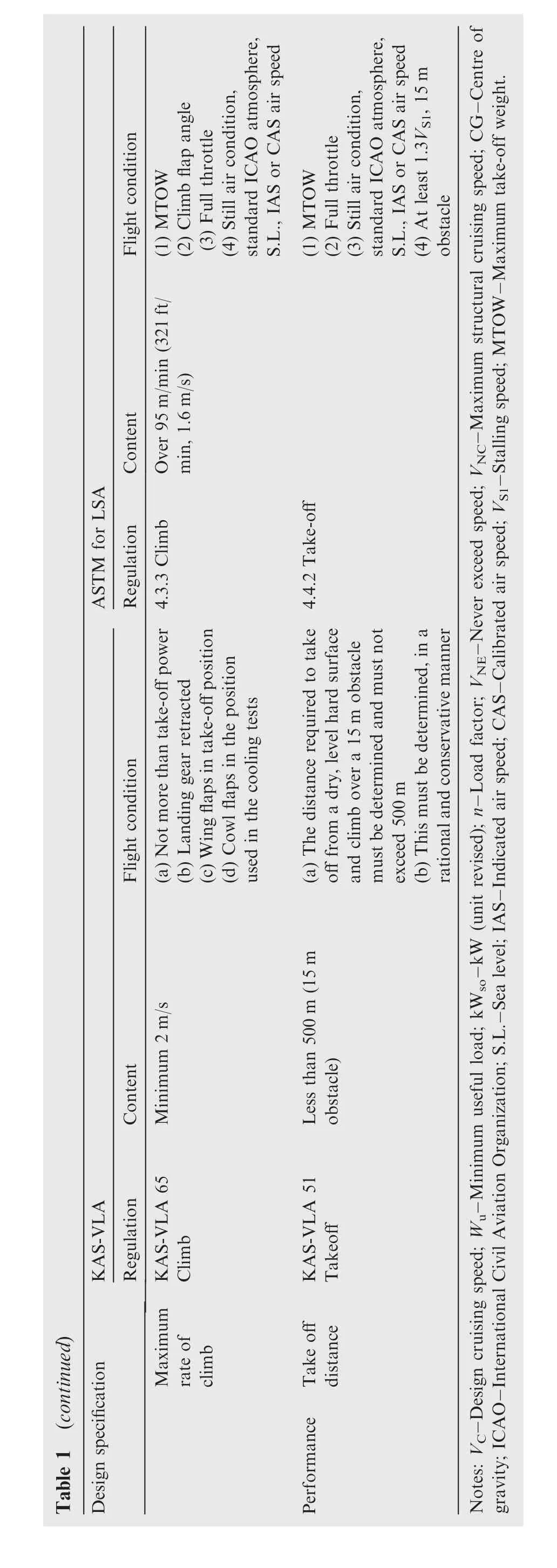
?
4.6.Analysis of temporary design requirements
The design requirements in the initial conceptual design phase for aircraft were classified into the user requirements,competing model-based requirements,and certification regulation requirements for analysis.Mission profiles for two-seater VLAs comprising warm up,taxiing,take off,climb,cruise,descent,reserve,landing and taxiing&shutdown were set up,as shown in Fig.12.The missions for flight range and cruising time for the analysis of user requirements are suggested in Table 2.The results of the temporary design requirement set are shown in Table 3 and a sizing interpretation tool was used to provide feasible values of the flight range and endurance under the given mission conditions.
4.7.Selection of baseline configurations

Fig.12 Mission profile.
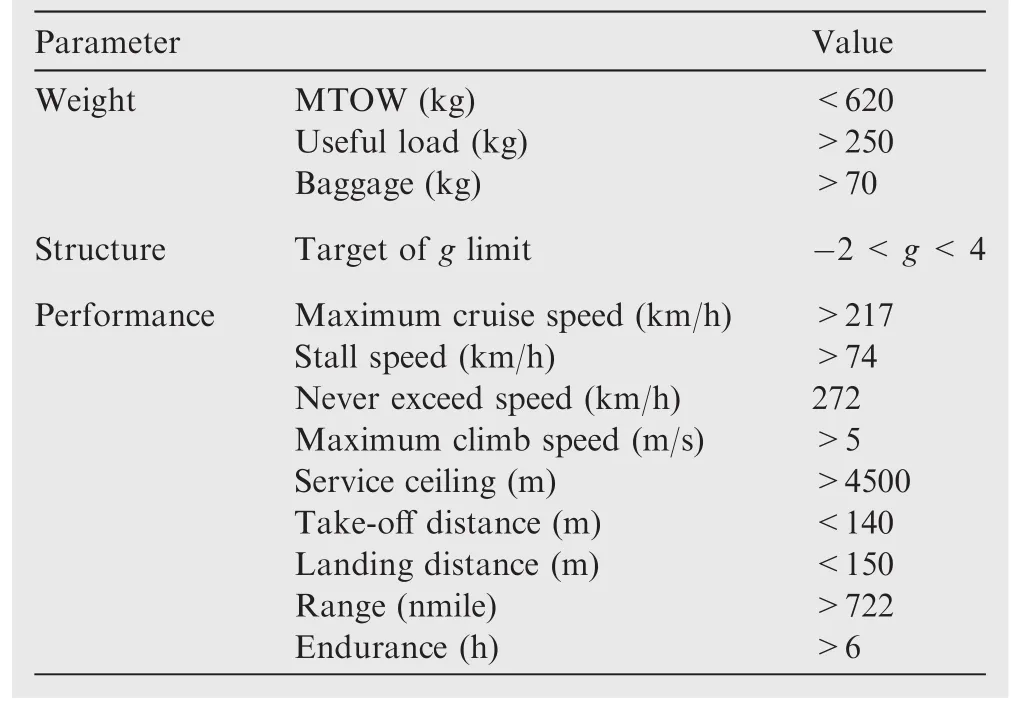
Table 3 Design requirements in initial conceptual design phase.
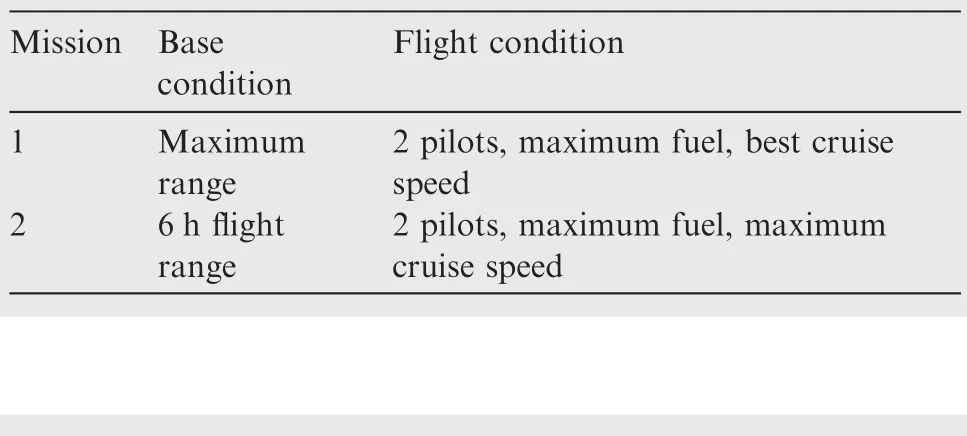
Table 2 Mission conditions.
The decision-making model was employed to quantitatively and systematically determine a baseline configuration for two-seater VLAs as shown in Fig.13.The vertical location of the main wings,tail wing configuration type,use of fuselage strut,and engine location were used as the baseline configura-tion elements in the initial conceptual design phase as shown in Table 4.A total of 16 different combinations could be made using the configuration elements,and the realizable configurations were then chosen as alternative configurations,as shown in Table 5.Table 6 shows the result of the TOPSIS20analysis conducted on each alternative configuration based on the objective categories in Level 2 of the tree diagram used in the analysis of customer requirements.Two families were selected as the resulting baseline configurations of the TOPSIS analysis.A high wing,a conventional tail wing,a fuselage strut,and a tractor-type engine were selected for the first baseline configuration,while a low wing,a conventional tail wing,no fuselage strut,and a tractor-type engine were selected for the second baseline configuration.The two selected baseline configurations,Family 1 and Family 2,were generated and their performances were analyzed in the conceptual design.This selection method for baseline configurations is more systematic,quantitative,and time-effective than the experiencebased baseline configuration selection process,which forms various types of families through an initial conceptual sketch and reduces the number of families throughout the design process.
In this phase,the configuration design elements must be well determined.Quantitative measures for decision-making can be suggested through the TOPSIS analysis using the determined configuration design elements.
For example,the TOPSIS analysis results in Table 6 indicate that,in light of the facts that the ‘safety’category of the user requirements has received the highest score and that airplanes with high wings hold a high rank,the quantitative analysis of the user requirements and the selection of the baseline configurations have promoted awareness of the safety of airplanes with high wings.On the other hand,since the safety of VLAs can be confirmed by obtaining the type certification,the Family 2 configuration could also be a strong alternative for VLAs based on the ‘marketability’and ‘performance’categories of the user requirements.

Table 4 Baseline configuration elements.
4.8.Verification and suggestion for design requirements
The temporary design requirements including the two missions,maximum flight range,and endurance are verified using a simple sizing tool and a performance interpretation tool.As a result,the primary design requirements are presented in Table 7.Six-hour endurance and a flight range of 1400 km are also presented as the mission goals.

Fig.13 Process of selecting baseline configurations.
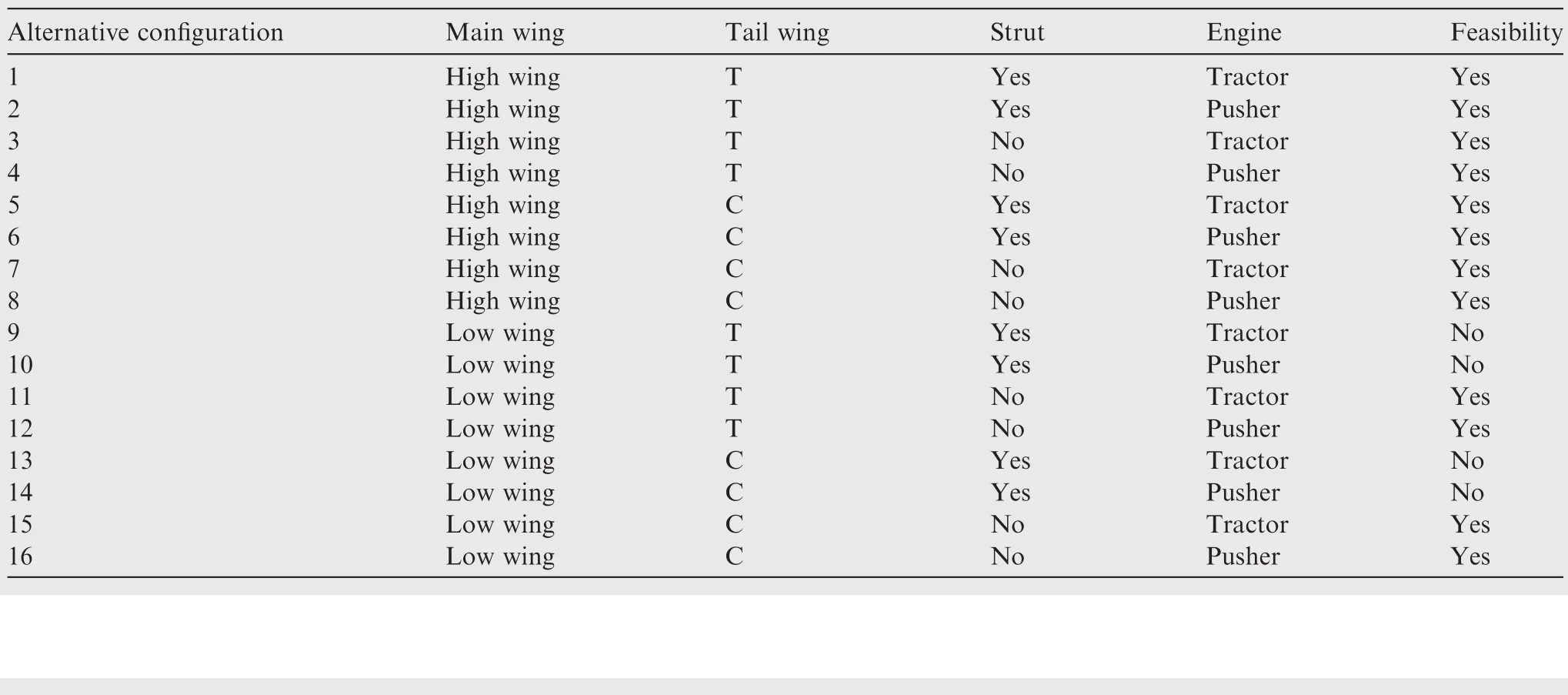
Table 5 Possible alternative configurations.

Table 6 Results of Pugh concept selection and TOPSIS.
4.9.Analysis result for conceptual designs in two baseline configurations
Through the analysis of the user requirements and the selection of baseline configurations using the TOPSIS,a high wing,a conventional tail wing with a fuselage strut,and a tractortype engine were selected for the first baseline configuration,while a low wing,a conventional tail wing,no fuselage strut,and a tractor-type engine were selected for the second baseline configuration.The first iteration of the conceptual design was executed with these two baseline configurations,Family 1 and Family 2.As a result,we were able to develop the configurations shown in Fig.14,and the performance results were obtained as summarized in Table 8.
A comparison of the design requirements and performance analysis results shows that the results for take-off distance and endurance do not fulfill the design requirements.Therefore,there is a need to alter the sizing to gain improved performance and satisfy the design requirements.Moreover,the current concept analysis tool used is not sensitive to configuration changes in terms of maximum cruising speed,actual climb limit,and endurance.Thus,there is a need to provide more sophisticated analysis tools.These were left as problems to be resolved as the development of VLAs was carried out henceforth.
In order to select a suitable configuration that meets the user requirements between Family 1 and Family 2,the conceptual design results corresponding to the evaluation categories in Level 2 in the user requirements analysis were quantitatively compared.In other words,the weight and the performance as well as the stability coefficient values computed through the conceptual designs of Family 1 and Family 2 were used for the TOPSIS analysis to extract the final baseline configuration.The TOPSIS analysis was conducted considering the following:the lighter the empty weight,the less it costs;the larger the internal space,the more it improves the comfort;the lighter the maximum take-off weight,the more it satisfies the weight requirements;the lower the fuel consumption rate,the more it reduces fuel consumption;and the more the stability coeff icient values satisfy the design requirements,the more they satisfy the basic characteristics of the aircraft.As a result,Family 2 received a higher score than that of Family 1.For that reason,a low wing,a conventional tail wing,no fuselage strut,and a tractor-type engine were selected as an optimal baseline configuration.
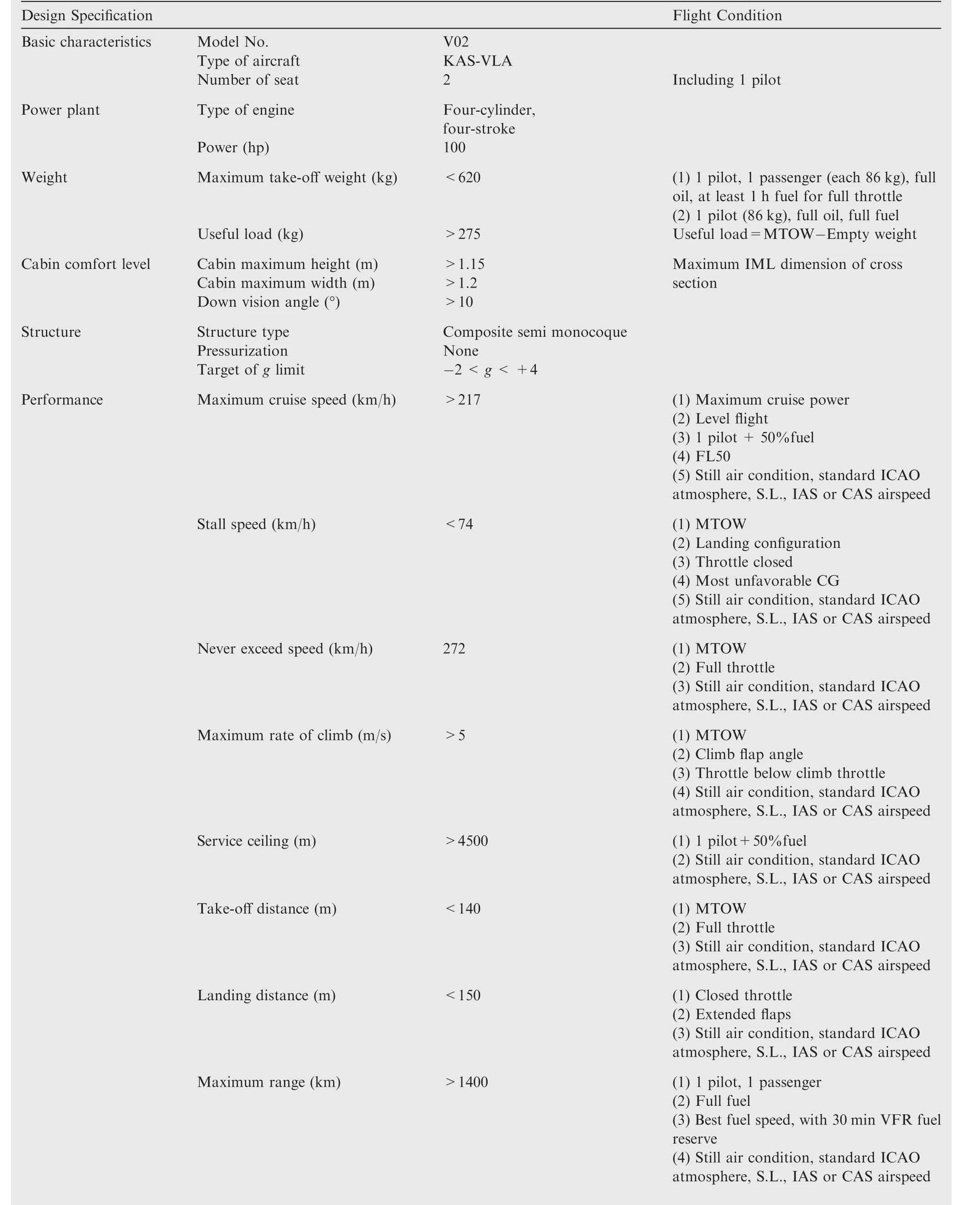
Table 7 Primary design requirements.
(continued on next page)

Table 7 (continued)
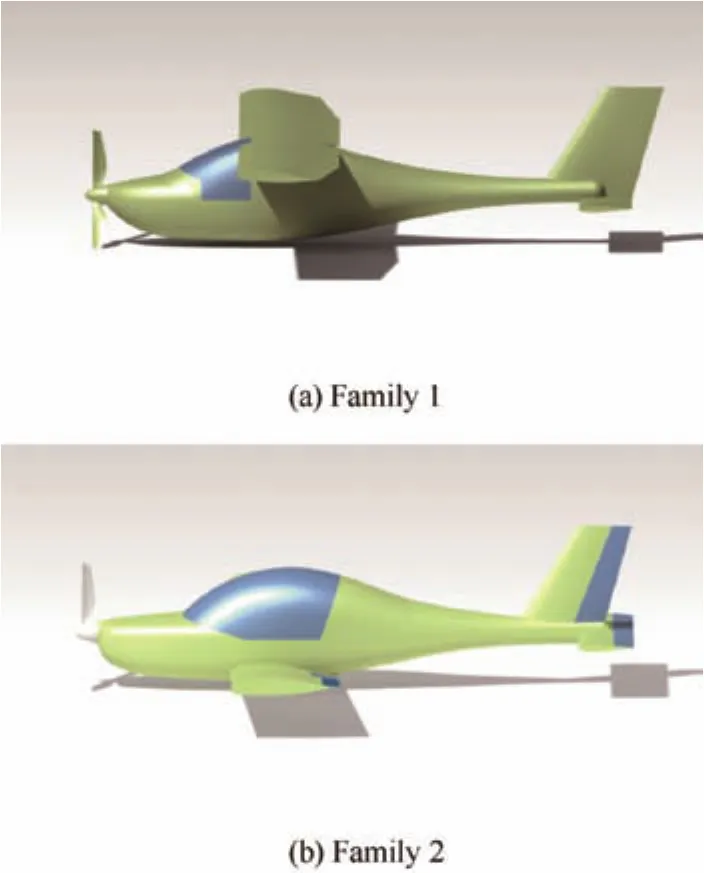
Fig.14 Baseline configurations of Family 1 and Family 2.9
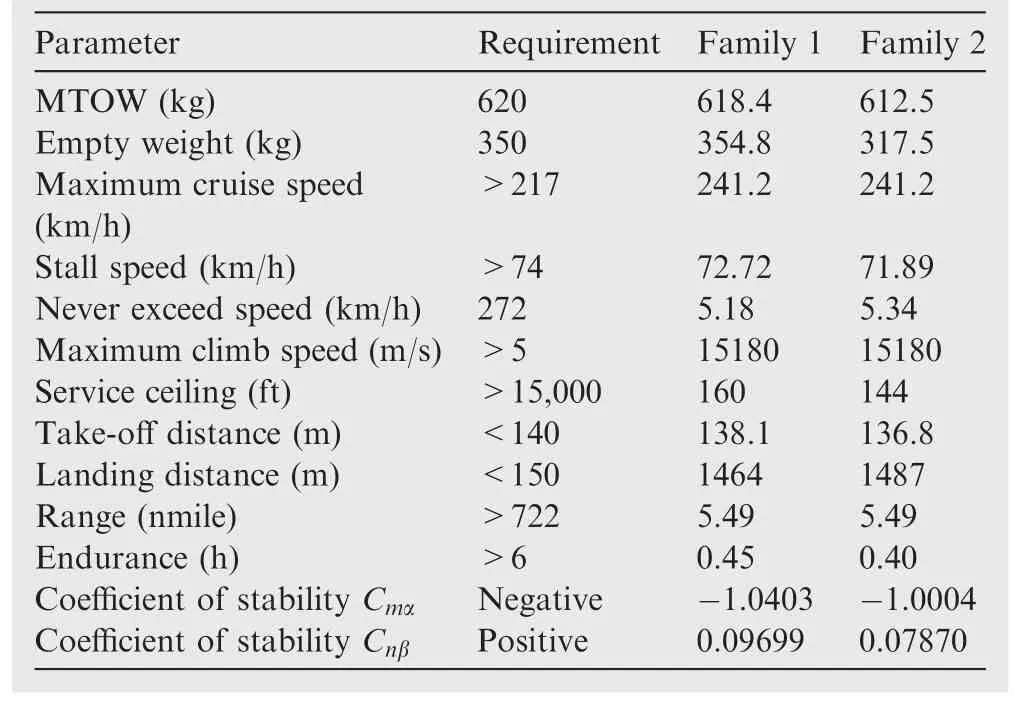
Table 8 Performance results for Family 1 and Family 2.9
5.Conclusions
This study has devised a method of establishing logical and quantitativestandardsby applying thedecision-making method.This study also proposed a process of evaluating and selecting various alternative configurations based on the devised standards in the initial conceptual design phase for aircraft development.A baseline configuration selection process using a quantitative requirements analysis method was established,and it was applied to a two-seater VLA,resulting in design requirements and baseline configurations at the initial conceptual design phase of the VLA development project.For the requirement analysis,the voices of users,designers,and clients were collected through a survey from various VLA experts and the survey data were efficiently reflected in the decision-making process.The user requirements,marketability,and certification regulations were taken into consideration for the analysis of the design requirements.In addition,measures to evaluate whether the current design technology can satisfy the user requirements in the early development stage were sought.A tree diagram up to Level 3 was made through the user requirements analysis,and the AHP analysis results showed that safety was the most important element.The order of priority and the figures of importance for each category were obtained through the primary and secondary QFD,which were linked to the design requirement settings and baseline configuration settings.Functions for computing the performance with respect to aircraft weights were formulated through the marketability analysis,that is,the analysis of the competing model-based requirements.The computed performance outputs were provided as the performance standard values for the design requirements.The results of the certification requirements analysis given by the CS-VLA and ASTM were set as constraints on the design requirements.
As a result,the temporary design requirements including two mission profiles were suggested.By applying the TOPSIS to the alternative configurations developed as combinations of configuration design elements in the conceptual design phase,the baseline configurations were set in two families.A high wing,a conventional tail wing,a fuselage strut,and a tractor-type engine were set for Family 1,while a low wing,a conventional tail wing,no fuselage strut,and a tractor-type engine were set for Family 2.For the two family configurations,the conceptual design and analysis were used in conducting the TOPSIS based on the quantitatively measured user requirements.In conclusion,Family 2 was selected as the optimal baseline configuration.The proposed requirement analysis and alternativeconfiguration selection processprovided improved objectivity and quantitation by systematic composition of the decision-making tools,QFD and TOPSIS.In particular,the present process introduced the initial sizing analysis tool to enforce the quantitative assessment in cooperation with the TOPSIS analysis.The efficiency of the process has been validated by applying it to the VLA development.
Acknowledgements
The authors are grateful for the support provided for this research by a grant(No.1615001723)from the Light Aircraft Development Program funded by the Ministry of Land,Infrastructure and Transport of the Korean government,and also the support from the National Research Foundation of Korea(No.NRF-2014R1A2A2A01003833)funded by the Korean government(MSIP).
1.Marvis DN,Baker AP,Schrage DP.Development of methodology for the determination of technical feasibility and viability of affordable rotorcraft systems.The 54th annual forum of the American Helicopter Society;1998 May 20–22;Washington,D.C.Fairfax(VA):American Helicopter Society;1998.
2.Kirby MR,Marvis DN.Forecasting technology uncertainty in preliminary aircraft design.The 4th world aviation congress and exposition;1999 October 19–21;San Francisco(CA).Warrendale(PA):SAE International;1999.
3.Park HU.Study on the robust aerospace system design optimization process[dissertation].Seoul:Konkuk University;2007.p.29–41[Korean].
4.Yoon JW,Nguyen N,Choi SM,Lee JW,Kim S,Byun YH.Multidisciplinary general aviation aircraft design optimizations incorporating airwothiness constraints.10th AIAA aviation technology integration and operation conference;2010 September 3–15;Fort Worth(TX).Reston:AIAA;2010.
5.Lee SJ,Chung WJ,Kim KJ.A study on optimal design an piece removing automation system using ARIZ and brainstorming based on DMADOV of 6sigma.KSMTE Spring Conference;2008 April;Seoul.Seoul:KSMTE;2008.p.6–7.[Korean].
6.Baek BS,Won YD.Quality management theory.Seoul:Trade Management Publishing Company;2001.p.114–50[Korean].
7.Lee SB,Shin DS.Theory of QFD and example.Seoul:I-Tech Publishing Company;2008.p.188–200[Korean].
8.Park YT.Single PPM quality innovation division of public administration.Seoul:Single PPM Quality Innovation Division;2000.p.78–96[Korean].
9.Lee JW.Light aircraft system requirement review.Seoul:Light Aircraft Development Center,Konkuk University;2011.p.7–13[Korean].
10.Lee JW.Research&planning report of light aircraft for sport class.Seoul:Light Aircraft Development Center,Konkuk University;2011.p.36–44[Korean].
11.Mizuno S,Akao Y.QFD:The customer driven approach to quality planning and deployment.Tokyo:Asian Productivity Organization;1994.p.339.
12.Chang DY.Application of the extent analysis method on fuzzy AHP.Eur J Oper Res1996;95(3):649–55.
13.Tom R.Problem structuring using computer-aided morphological analysis.J Oper Res Soc2006;57(7):792–801.
14.Shon KY,Yang JW,Kang CS.Assimilation of public opinions in nuclear decision-making using risk perception.Ann Nucl Energy2001;28(6):553–63.
15.Lee JW.Aircraft conceptual design.Seoul:Kyungmun Publishing Company;2001.p.25–36[Korean].
16.Nguyen NV,Tyan M,Lee JW.A modified variable complexity modeling for efficient multi-disciplinary aircraft conceptual design.Optimiz Eng2015;16(2):483–505.
17.Park HU,Park MY,Lee SJ,Lee JW,Byun YH.Development of requirement driven design concept selection process in aerospace system.Computational science and its applications—ICCSA 2006;2006 May 8–11;Glasgow.New York:Springer-Verlag;2006;3984.p.512–21.
18.Satty TL.The analytic hierarchy process.Boston:Klumer-Nijhoff Publishing;1982.p.192–213.
19.Chakldar ND,Charaborty S.A combined TOPSIS-AHP method based approach for non-traditional machining process selection.Proc Inst Mech Eng Part B:J Eng Manuf2008;222(12):1613–23.
20.Ministry of Land,Infrastructure and Transport.Korean airworthiness standards.Korea[updated 2010 May12;cited 2016 Jan 20].[Korean].
18 January 2016;revised 11 August 2016;accepted 27 October 2016
Available online 17 March 2017
*Corresponding author.
E-mail address:kimsh85@konkuk.ac.kr(S.Kim).
Peer review under responsibility of Editorial Committee of CJA.
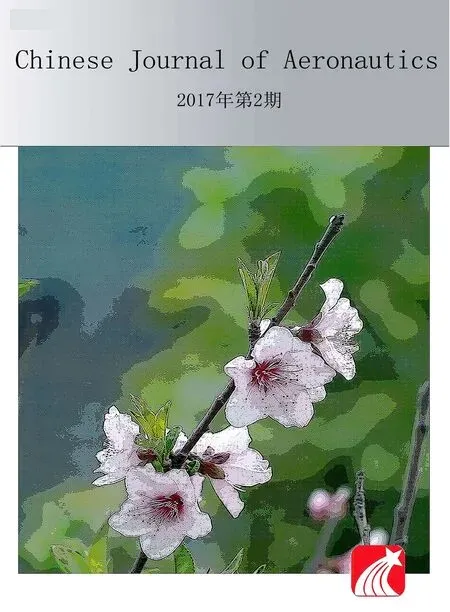 CHINESE JOURNAL OF AERONAUTICS2017年2期
CHINESE JOURNAL OF AERONAUTICS2017年2期
- CHINESE JOURNAL OF AERONAUTICS的其它文章
- High-temperature tribological behaviors of a Cr-Si co-alloyed layer on TA15 alloy
- Analysis and control of the compaction force in the composite prepreg tape winding process for rocket motor nozzles
- Impact of lubricant traction coefficient on cage’s dynamic characteristics in high-speed angular contact ball bearing
- Variable stiffness design of redundantly actuated planar rotational parallel mechanisms
- Adaptive formation control of quadrotor unmanned aerial vehicles with bounded control thrust
- Constrained adaptive neural network control of an MIMO aeroelastic system with input nonlinearities
